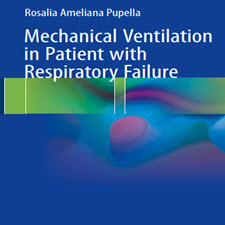Mechanical Ventilation in Patient with Respiratory Failure
ABSTRACT
An important point to appreciate how ventilation occurs is the concept of gas flow itself. Gas has its own characteristics, like when it is on sea level, it is different compared when it is under sea level or even above sea level. This means even the gas or air inside our lungs, e.g., oxygen and carbon dioxide, changes its characteristics on sea level, under sea level, or above sea level. In this chapter, basic mathematics and physics will be explained. They are related to gas characteristics in the lungs and also related to the tables and graphs shown on ventilator. Mechanical ventilator also shows graphs of flow, pressure, and volume. In the following chapter, all those variables which are often encountered on mechanical ventilator will be discussed; the relationship of flow and resistance to pressure, which is related to pressure from mechanical ventilator against resistance in the lungs and even the ventilator tubings, will also be in this chapter. In mechanical ventilator, there are various flow patterns, square, decelerating, and sinus waveform, which will be explained and shown further in this chapter.
INTRODUCTION
Ventilatory support should be initiated when a patient’s spontaneous breathing is not enough to maintain gas exchange, which causes gas exchange to fail, putting the patient in a life-threatening situation if support is not provided. Gas exchange failure or inadequate gas exchange means that either oxygen or carbon dioxide or even both in the arterial blood are not at normal levels. This is called respiratory failure. Respiratory failure is classifed as hypoxemic and hypercapnic. The principal benefts of mechanical ventilation on patients with respiratory failure are improved gas exchange in the lungs and decreased work of breathing. During spontaneous breathing, it is simply the air which is moving into and out of the lungs. The contraction of respiratory muscles causes the thorax to expand; therefore, the air in the atmosphere goes into the lungs. This is how spontaneous breathing occurs. During ventilation with mechanical ventilator, the user has to consider the lung condition or the diagnosis of the patient in order to fulfll the best ventilation for the patient. The things to be considered are dead space of the airway of the patient, lung compliance, etc.
چکیده
یک نکته مهم برای درک اینکه چگونه تهویه ایجاد می شود، مفهوم جریان گاز است. گاز ویژگی های خاص خود را دارد، مانند زمانی که آن را در سطح دریا، متفاوت است در مقایسه با زمانی که آن را در زیر سطح دریا و یا حتی بالاتر از سطح دریا. این به این معنی است که حتی گاز یا هوا درون ریه های ما، مانند اکسیژن و دی اکسید کربن، ویژگی های آن را بر سطح دریا، سطح دریا و یا بالاتر از سطح دریا تغییر می دهد. در این فصل، ریاضیات و فیزیک پایه توضیح داده خواهد شد. آنها مربوط به ویژگی های گاز در ریه ها و همچنین مربوط به جداول و نمودار های نشان داده شده در تهویه است. تهویه مکانیکی همچنین نمودارهای جریان، فشار و حجم را نشان می دهد. در فصل بعد، تمام آن متغیرهایی که اغلب روی دستگاههای مکانیکی مواجه می شوند بحث خواهند شد. رابطه جریان و مقاومت در برابر فشار، که به فشار از طرف دستگاه مکانیکی در مقابل مقاومت در ریه ها و حتی لوله های تهویه مطبوع است، نیز در این فصل وجود دارد. در تهویه مکانیکی، الگوهای مختلف جریان، مربع، کند کننده و شکل موج سینوس وجود دارد که در این فصل توضیح داده شده و نشان داده شده است.
مقدمه
حمايت تهویه ای باید زمانی آغاز شود که تنفس خود به خودی خود برای حفظ تبادل گاز به اندازه کافی کافی نیست، که باعث می شود مبادله گاز ناکام بماند و بیمار در وضعیت تهدید کننده زندگی قرار گیرد، اگر حمایت نباشد. شکست گاز یا تبادل گاز نامناسب بدین معنی است که اکسیژن، دی اکسید کربن یا حتی هر دو در خون شریانی در سطوح نرمال نیستند. این نارسایی تنفسی است. شکست تنفسی به عنوان هیپوکسمی و هیپاپکینک طبقه بندی می شود. تأثیر اصلی تهویه مکانیکی در بیماران مبتلا به نارسایی تنفسی بهبود تبادل گاز در ریه ها و کاهش کار تنفس است. در طی تنفس خودبهخودی، هوا به راحتی به داخل و خارج از ریه منتقل می شود. انقباض عضلات تنفسی باعث می شود که قفسه سینه گسترش یابد؛ بنابراین، هوا در جو به ریه ها می رسد. این است که چگونه نفس خودبهخود رخ می دهد. در حین تهویه با تهویه مکانیکی، کاربر باید شرایط ریه یا تشخیص بیمار را در نظر بگیرد تا بهترین تهویه برای بیمار را انجام دهد. چیزهایی که در نظر گرفته می شود فضای مرده راه هوایی بیمار، رعایت ریه و غیره است.
Year: 2016
Publisher: SPRINGER
By : Rosalia Ameliana Pupella
File Information: English Language/ 158 Page / size: 9.07 MB
Only site members can download free of charge after registering and adding to the cart
سال : 1395
ناشر : SPRINGER
کاری از : Rosalia Ameliana Pupella
اطلاعات فایل : زبان انگلیسی / 158 صفحه / حجم : MB 9.07
[sdfile url =”http://dl.taliem.ir/book/pezeshki/Mechanical.Ventilation.in.Patient-taliem.ir.rar”]


![Reconstructing.the.War.Injured.Patient.[taliem.ir] Reconstructing.the.War.Injured.Patient.[taliem.ir]](https://taliem.ir/wp-content/uploads/Reconstructing.the_.War_.Injured.Patient.taliem.ir_.jpg)
![Organizing.Patient.Safety.Failsafe.Fantasies.[taliem.ir] Organizing.Patient.Safety.Failsafe.Fantasies.[taliem.ir]](https://taliem.ir/wp-content/uploads/Organizing.Patient.Safety.Failsafe.Fantasies.taliem.ir_.jpg)

![Mechanical Properties of Polymer Concrete[taliem.ir] Mechanical Properties of Polymer Concrete[taliem.ir]](https://taliem.ir/wp-content/uploads/Mechanical-Properties-of-Polymer-Concretetaliem.ir_.jpg)
![ECMO.in.the.Adult.Patient.[taliem.ir] ECMO.in.the.Adult.Patient.[taliem.ir]](https://taliem.ir/wp-content/uploads/ECMO.in_.the_.Adult_.Patient.taliem.ir_.jpg)
![Applied.Structural.And.Mechanical.Vibrations.[taliem.ir] Applied.Structural.And.Mechanical.Vibrations.[taliem.ir]](https://taliem.ir/wp-content/uploads/Applied.Structural.And_.Mechanical.Vibrations.taliem.ir_.jpg)
![Mechanical and Thermal Properties of the[taliem.ir] Mechanical and Thermal Properties of the[taliem.ir]](https://taliem.ir/wp-content/uploads/Mechanical-and-Thermal-Properties-of-thetaliem.ir_.jpg)



دیدگاه خود را ثبت کنید
تمایل دارید در گفتگو شرکت کنید؟نظری بدهید!